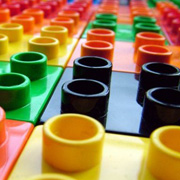


Thankfully toy safety in the 21st Century is generally very good, with manufacturers putting more care and attention that ever before into the materials used and the quality of production. It's a sad fact though, that every year a number of children end up in casualty departments because of toy-related injuries. Below we have outlined our top ten tips for choosing safe toys for your baby or toddler at any time of the year.
1.) Pay attention to toy safety symbols
There are various safety marks that warn of possible danger; the most important being the age warning symbol that tells you that the toy is not safe for children younger than three years old.
2.) Check the toy's size
A very small toy – or a toy with small parts that can be dislodged from the main toy - are choking hazards and should not be given to a child that is likely to put it in their mouth. When trying to choose safe toys for your child you should also pay attention to squeezy toys that may naturally be a good size but can shrink substantially when squashed.
3.) Check for long cords or strings
Cords and strings present a potential strangulation hazard - so very young children should be supervised when using a pull-along toy or a toy with attached string or rope.
4.) Investigate the materials used in the toy's production
It's very important to know what materials that have been used to make the toy you are looking to buy. Check that...
• fabric toys are clearly labelled as being flame resistant
• arts & crafts products are labelled as non-toxic
• painted toys use lead-free paint
• the product is free from BPA, Phthalates and lead
• there are no sharp edges or points
5.) Buy from reputable retailers
Every industry is susceptible to counterfeit goods – and the toy industry is no different. Never buy a toy unless you can be sure it's the genuine article.
6.) Beware of old toys
Handing down toys through generations is popular for a nostalgia and cost point of view. Don't presume that toys made in years gone by have had the same level of diligence in their production as toys made recently. Also bear in mind that pre-loved toys are likely to be more susceptible to breakage.
7.) Make sure the toy isn't too loud
Young children's ears are very delicate - and babies and toddlers tend to hold toys close to their head. It's therefore important to check how loud a toy is because if used very close to an ear then there is a risk of permanent hearing damage.
8.) Consider protective clothing
When children get older and become more daring, the most likely danger is going to be falling over – whether it's out of a tree or off a scooter! Although you can never take all risk away, protective clothing including helmets and elbow pads will protect your child from most serious injuries.
9.) Make sure the toy cannot be confused for a weapon
Thankfully hyper-realistic toy guns are all but gone from toy shop shelves now, but make sure than any toy guns are made from bright colours so that they could never be confused for a real weapon.
10.) Check the toy media for recalled toys
Keeping an eye on recalled toys will ensure that any toys you have in your house are not on the danger list. Websites like UK Recall Notice can be used for this purpose.